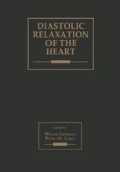Abstract
An unappreciated change in pericardial pressure may alter the interpretation of measurements of left ventricular isovolumic relaxation and of the diastolic pressure-volume relationship both qualitatively and quantitatively. However, before these problems can be discussed it is necessary to define what is meant by pericardial pressure and to specify its magnitude.
Access this chapter
Tax calculation will be finalised at checkout
Purchases are for personal use only
Preview
Unable to display preview. Download preview PDF.
References
Tyberg JV, Smith ER (1987). On the interaction between the pericardium and the heart. In ter Keurs HEDJ, Tyberg JV: Mechanics of the Circulation Dordrecht/Boston-Lancaster: Martinus Nijhoff, 71–188.
Holt JP, Rhode EA, Kines H (1960). Pericardial and ventricular pressure. Circ Res 8: 1171–1181.
Smiseth OA, Frais MA, Kingma I, et al (1985). Assessment of pericardial constraint in dogs. Circulation 71: 158–164.
Rankin JS, Arentzen CE, McHale PA, et al (1977). Viscoelastic properties of the diastolic left ventricle in the conscious dog. Circ Res 41: 37–45.
Refsum H, Junemann M, Liopton MG, et al (1981). Ventricular diastolic pressure-volume relations and the pericardium: Effect of changes in blood volume and pericardial effusion in dogs. Circulation 64: 997–1004.
Linderer T, Chatterjee K, Parmley WW, et al (1983). Influence of atrial systole on the Frank-Starling relation and the end-diastolic pressure-volume relation in the left ventricle. Circulation 67: 1045–1053.
Tyberg JV, Tatchman GC, Smith ER, et al (1986). The relation between pericardial pressure and right atrial pressure: An intraoperative study. Circulation 73: 428–432.
Douglas N, Kingma I, Smiseth O, et al (1984). Assessment of left ventricular preload during PEEP from pulmonary capillary wedge pressure and right atrial pressure in dogs. Clin Invest Med 7 (suppl 3): 41 (abstract).
LeWinter MM, Pavelec R: Influence of the pericardium on left ventricular end-diastolic pressure-segment relations during early and later stages of experimental chronic volume overload in dog. Circ Res 50: 501–509.
Weiss JL, Frederiksen JW, Weisfeldt ML (1976). Hemodynamic determinants of the time-course of fall in canine left ventricular pressure. J Clin Invest 58: 751–760.
Frais MA, Kingma I, Groves G et al (1983). The dependence of the time constant of left ventricular relaxation on pericardial pressure. J Am Coll Cardiol 1: 627 (abstract).
Craig WE, Murgo JP (1980). Evaluation of isovolumic relaxation in normal man during rest, exercise and isoproterenol infusion. Circulation 62(suppl III1: III - 22 (abstract).
Thompson DS, Waldron CB, Juul SM, et al (1982). Analysis of left ventricular pressure during isovolumic relaxation in coronary artery disease. Circulation 65: 690–697.
Thompson DS, Waldron CB, Coltart DJ, et al (1983). Estimation of time constant of left ventricular relaxation. Br Heart J 49: 250–258.
Serizawa T, Carabello BA, Grossman W (1980). Effect of pacing-induced ischemia on left ventricular diastolic pressure-volume relations in dogs with coronary stenoses. Circ Res 46: 430–439.
Kingma I, Smiseth OA, Belenkie I, et al (1986). A mechanism for the nitroglycerin-induced downward shift of the left ventricular diastolic pressure-diameter relationship of patients. Am J Cardiol 57: 673–677.
Brodie BR, Chuck L, Klausner SC, et al (1976). Effects of sodium nitroprusside and nitroglycerin on tension prolongation of cat papillary muscle during recovery from hypoxia. Circ Res 39: 596–601.
Braunwald E, Ross J Jr (1963). The ventricular end-diastolic pressure. Am J Med 34: 147–150 (editorial).
Editor information
Editors and Affiliations
Rights and permissions
Copyright information
© 1987 Martinus Nijhoff Publishing
About this chapter
Cite this chapter
Tyberg, J.V., Scott-Douglas, N.W., Kingma, I., Traboulsi, M., Smith, E.R. (1987). Implications of Pericardial Pressure for the Evaluation of Diastolic Dysfunction. In: Grossman, W., Lorell, B.H. (eds) Diastolic Relaxation of the Heart. Springer, Boston, MA. https://doi.org/10.1007/978-1-4615-6832-2_17
Download citation
DOI: https://doi.org/10.1007/978-1-4615-6832-2_17
Publisher Name: Springer, Boston, MA
Print ISBN: 978-1-4615-6834-6
Online ISBN: 978-1-4615-6832-2
eBook Packages: Springer Book Archive

